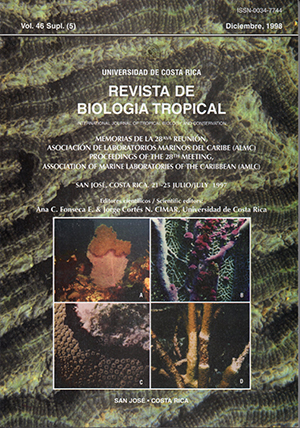Abstract
This study, done at Morrocoy National Park, Venezuela, describes and analyzes tumor-like growths resulting from the invasion of Plexaura flexuosa axial skeleton and surrounding tissues by filaments of the chlorophycean Entocladia endozoica. A stratified random sampling was done in three transects of 72 m2 each at 4,8 and 12 m depth. At each depth, all tumors present in nine randomly chosen colonies of P. flexuosa were cut and preserved and five tumors ere collected in each of the remaining colonies on the transect. The external and internal morphology of the tumors and the spatial relationship of the algal filaments with the axial rod of the octocoral was studied through standard microscopy and scanning electron microscopy. Transmission electron microscopy was used for taxonomic purposes and to identify the reproductive stage of the filaments. In addition, optical fiber sensors were used to detect the light path of laser beam projected from a discharge lamp through the coenenchymal material of the tumor, in order to find out if ambient light can reach the algal filaments. Results showed that the E. endozoica filaments in a tumor of P. Flexuosa were found on the tips of axis projections of variable size that were perpendicular to the main rod. These projections often penetrate the axial sheath towards the coenenchyma and could contact the ambient water through fractures of the external wall of the tumor. Reproductive filaments were only found on axis projections that had grown enough to penetrate the axial sheath and the coenenchyma. Filaments on the main axial rod or on small projections were in the vegetative stage. The laser study indicated that the light could at least reach the coenenchymal material where the reproductive filaments are found. We postulate a mechanism through which the oetocoral tries to get rid of the algal filaments by pushing them out by the development of projections, thus causing vegetative filaments to be come reproductive. Light may also contribute to this transformation.##plugins.facebook.comentarios##

This work is licensed under a Creative Commons Attribution 4.0 International License.
Copyright (c) 1998 Revista de Biología Tropical
Downloads
Download data is not yet available.


